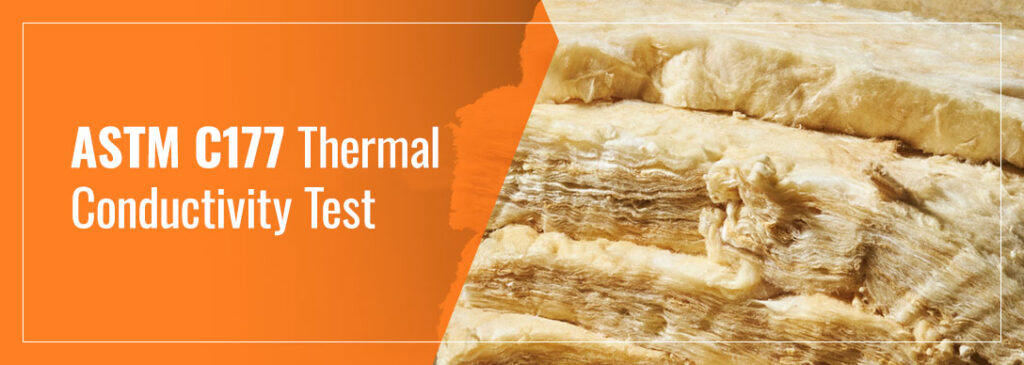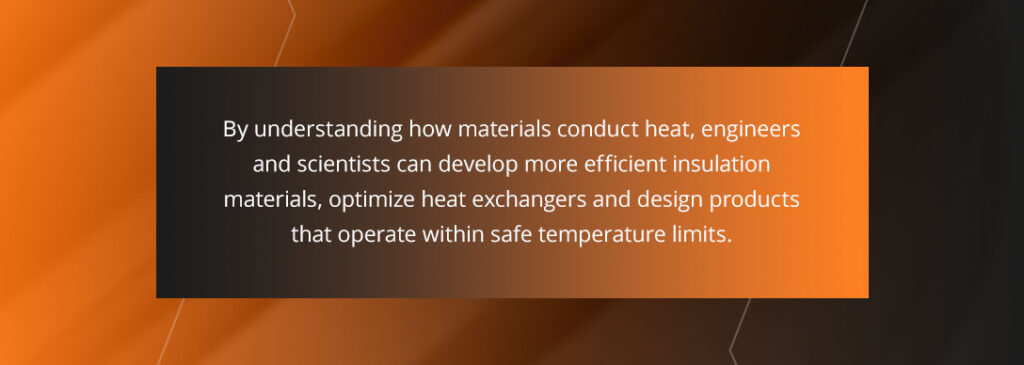ASTM C177 Thermal Conductivity Test

ASTM C177 Testing Lab
The ASTM C177 is the standard test for measuring a material's thermal conductivity by means of a guarded-hot-plate instrument. For a material to be classified as a thermal insulator, it must exhibit low thermal conductivity throughout this test — which, though not identical, is comparable to ISO 8302.
Through the ASTM C177 test, a method is established for measuring steady-state heat transfer across homogeneous flat specimens by exposing their parallel surfaces to a steady heat source, typically a guarded-hot-plate instrument. This measuring takes place under laboratory conditions and allows for repeatable results.
Many factors — from environmental conditions and equipment calibration to specimen mounting and homogeneity — need to be fully taken into consideration and controlled for effective and accurate ASTM C177 testing. In addition, the professionals conducting the test must be experienced in thermal analysis, data collection and measurement. If testers do not possess thorough technical knowledge of heat flow and transfer or these conditions aren’t met, any thermal conductivity test results are questionable at best.
At VTEC Laboratories, we’ve been providing high-quality thermal conductivity analysis and testing to a broad range of sectors — including manufacturing, aerospace, plastics, chemical, transportation, electronics, military and more — for well over three decades.
What Is the ASTM C177 Thermal Conductivity Test?
The ASTM C177 test is a standard method established by the American Society for Testing and Materials (ASTM). It's designed to determine the steady-state heat flux and temperature differences across flat slab specimens. This test method evaluates the thermal insulation properties of materials under specific conditions, offering valuable insight into their performance in terms of heat transfer.
ASTM C177 is the ideal materials test to accurately measure the heat flux of a pair of flat identical specimens mounted on each side of the guarded-hot-plate instrument. This method gauges the rate of heat flow through the specimens, factoring in their total thickness and temperature gradient across that thickness.

Information gathered from the ASTM C177 test contributes to innovation. By understanding how materials conduct heat, engineers and scientists can develop more efficient insulation materials, optimize heat exchangers and design products that operate within safe temperature limits. Proper testing allows your operation to create materials that work precisely as needed to promote safety, efficiency and productivity.
What Do Thermal Conductivity Tests Measure?
Thermal conductivity tests determine a material's ability to conduct heat. This property is crucial in various fields, from engineering to materials science. The test measures how quickly heat travels through a substance when applying a temperature gradient. A higher thermal conductivity value indicates efficient heat transfer, while a lower value suggests insulating properties.
These tests are vital for optimizing energy efficiency, designing effective insulation and selecting appropriate materials for specific applications. In electronics, thermal conductivity helps ensure components remain within safe operating temperatures. In construction, it aids in designing energy-efficient buildings by identifying materials that can resist heat transfer. Additionally, thermal conductivity testing contributes to advancements in materials development, enabling innovations in the aerospace, automotive and manufacturing industries.
By providing insights into heat transfer mechanisms, thermal conductivity tests guide engineers and scientists in making informed decisions about material selection, design and optimization. This knowledge ultimately drives improvements in technology, energy conservation and overall product performance.
ASTM C177 Thermal Conductivity Testing Method
The scope of the ASTM C177 test extends to a wide range of materials, including thermal insulators, construction materials, textiles, foams and composites. The test quantifies thermal conductivity by subjecting these materials to controlled temperature gradients. This information is essential for industries where efficient thermal insulation and management are paramount.
To yield accurate results, it’s critical that both specimens are as identical in thickness, density and shape as possible. Any deviations from the specimens’ homogeneity and similarity can interfere in the flow of heat, which alters the temperatures various measuring devices and thermocouples read.
The test involves placing two specimens on either side of a guarded hot-plate instrument. In this arrangement, guard — or auxiliary — heaters minimize the transfer of lateral heat from the main heater — or the hot plate — and help concentrate heat flow at the subjects that are mounted parallel outside the main heater.
The total heat transferred to the specimens equals the supplied power to the hot-plate. Equilibrium occurs when voltage and temperature readings become steady.
With the k=P/[t*(Tm– Ta)] equation, we can calculate thermal conductivity. Using this calculation, P represents power, t is the combined specimens’ thickness, Tm is the main heater’s temperature and Ta is the auxiliary heater’s temperature.
VTEC Is Your Certified Thermal Conductivity Testing Lab
As an A2LA and ISO accredited laboratory, we’re always prepared to conduct standardized testing to meet the strictest requirements of most governing bodies such as Underwriters Laboratories (UL), the International Standards Organization (ISO) and, of course, the ASTM — especially as it applies to ASTM C177. As an ISO 17020, 17025 and 17065 accredited lab, we deliver results that go above and beyond industry standards in quality, accuracy and speed. In addition, we’re also happy to meet all of your customized testing needs including the designing, building and installation of custom-made test apparatus.
Get a Free Quote
VTEC offers ASTM C177 testing services to assess your materials' heat transfer capabilities. Our professional testing provides valuable insights into your materials' heat management capabilities. Results from our tests enable you to make the most informed decisions and foster innovation across diverse sectors.
Investing in customized testing delivers the accurate, tailored results you need to optimize your operation. With an average turnaround time of two weeks, you'll get results at an unmatched speed. If you want them faster to meet your timelines, reach out to our expert team, and we can get you the results you need when you need them.
For more information regarding our ASTM C177 testing services, request a quote or call us at 718-542-8248.
Along With ASTM C177, Customers Also Requested:
- ASTM C201 - Thermal Conductivity of Refractories
- ASTM C518 - Measuring Steady-State Thermal Transmission
Learn More About VTEC Services
At VTEC Laboratories, our role as a multi-functional company stems from our more than three decades of experience. Due to our extensive expertise in multiple industries, we provide comprehensive services that meet each field’s unique standards, needs and objectives.
Learn more about our services by contacting us online or calling us at (718) 542-8248.

